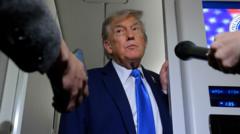As NATO leaders gear up for their upcoming summit, domestic pressures intensify to meet the ambitious military spending targets pushed by President Trump, revealing both potential obstacles and oversights within alliance policies.
NATO's Struggles: Balancing Military Spending and Trump’s Demands

NATO's Struggles: Balancing Military Spending and Trump’s Demands
NATO prepares for a summit as it grapples with the challenge of satisfying President Trump's military spending expectations.
In anticipation of the NATO summit scheduled to begin next Tuesday in The Hague, a backdrop of military readiness and coalition unity has transitioned into a palpable urgency to appease President Trump. This shift has prompted U.S. allies to dilute their publicly stated support for Ukraine's NATO membership while drafting an unusually concise policy communiqué that might only stretch five paragraphs. In a bid to avoid friction, the summit's structure has been designed to be executed swiftly, concluding in under two days.
According to Mujtaba Rahman, an analyst at the Eurasia Group, "No one wants to say no to Trump." With the tension surrounding a potential international crisis impacting the Middle East, the President assured reporters that he would still attend the NATO meeting.
However, his presence will certainly overshadow the proceedings, primarily influencing NATO Secretary General Mark Rutte's push for an increase in military expenditure among the alliance's 32 member states. Trump's target has been raised from the current allocation of 2% of each nation's gross domestic product (GDP) to a staggering 5%. To meet these new demands, Secretary Rutte has suggested a broader interpretation of what constitutes military spending, incorporating 3.5% of GDP for what is termed core defense expenditures and the remainder for “defense and security-related investment, including infrastructure and resilience."
As the specifics of Rutte's proposals gradually materialize, both their potential pitfalls and logistical complications have surfaced. There remains uncertainty regarding the individual timelines for member states to ramp up spending, alongside confusion about the metrics of compliance. Additionally, concerns mount over whether Europe's or even America's defense sectors can effectively absorb the increased funding or
deliver the requisite military assets within a reasonable timeframe.
According to Mujtaba Rahman, an analyst at the Eurasia Group, "No one wants to say no to Trump." With the tension surrounding a potential international crisis impacting the Middle East, the President assured reporters that he would still attend the NATO meeting.
However, his presence will certainly overshadow the proceedings, primarily influencing NATO Secretary General Mark Rutte's push for an increase in military expenditure among the alliance's 32 member states. Trump's target has been raised from the current allocation of 2% of each nation's gross domestic product (GDP) to a staggering 5%. To meet these new demands, Secretary Rutte has suggested a broader interpretation of what constitutes military spending, incorporating 3.5% of GDP for what is termed core defense expenditures and the remainder for “defense and security-related investment, including infrastructure and resilience."
As the specifics of Rutte's proposals gradually materialize, both their potential pitfalls and logistical complications have surfaced. There remains uncertainty regarding the individual timelines for member states to ramp up spending, alongside confusion about the metrics of compliance. Additionally, concerns mount over whether Europe's or even America's defense sectors can effectively absorb the increased funding or
deliver the requisite military assets within a reasonable timeframe.




















